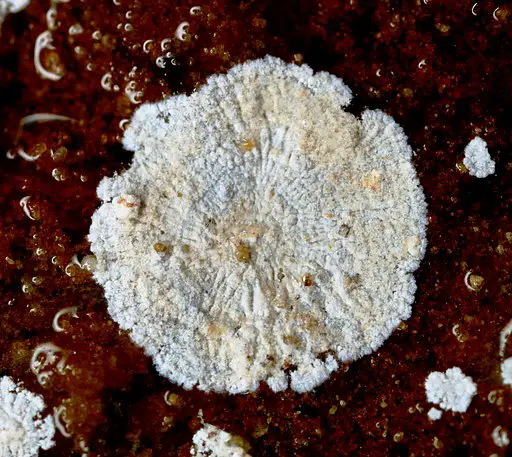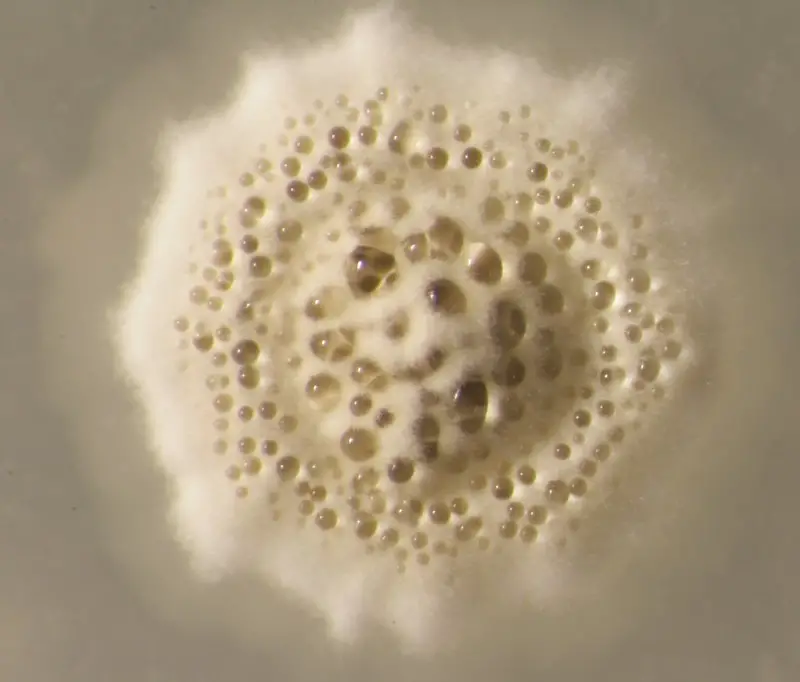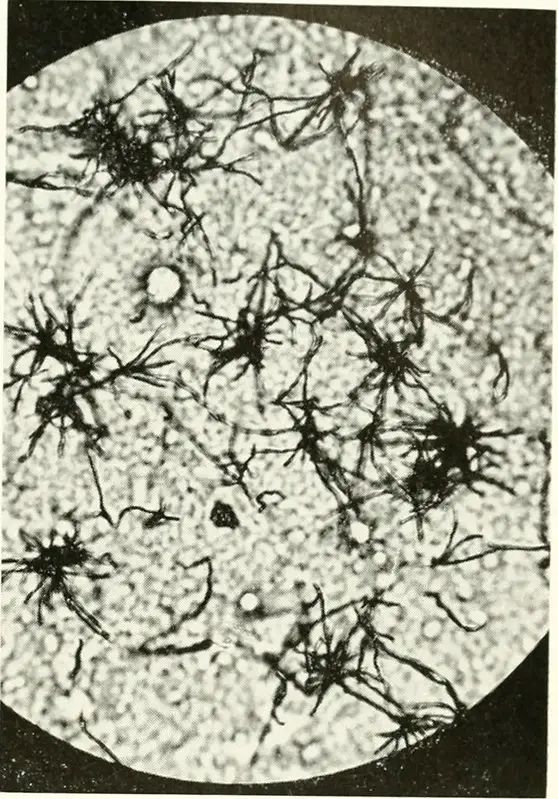Actinomycetes
Definition, Classification, Characteristics, Ecology and Culture
Definition: What are Actinomycetes?
Actinomycetes are unicellular, Gram-positive bacteria that belong to the Order Actinomycetales.
Members of this group are widely distributed in nature and can be found in a variety of habitats across the world. They have been shown to share a number of characteristics with fungi (e.g. mycelial growth) and cause the same disease as fungi in the eye.
Apart from being widely distributed, Actinomycetes are also nutritionally versatile and capable of producing different kinds of spores. These characteristics have allowed the group to successfully compete with other organisms in their surroundings.
While some members of this group cause diseases (e.g. actinomycosis caused by Actinomyces israelii), they are important soil organisms (where they break down various recalcitrant organic compounds) and also produce biologically active compounds that have been used as antibiotics and insecticides, etc.
Examples of Actinomycetes include:
- Actinomyces meyeri
- Actinomyces israelii
- Nocardia brasiliensis
- Nocardia asteroides
- Streptomyces coelicolor
- Streptomyces scabies
* The name Actinomycetes is derived from the Greek words "atkis" which means ray and "mykes/mukes" which means fungi.
Classification
Kingdom: Bacteria - As members of the kingdom Bacteria, Actinomycetes are unicellular organisms characterized by a simple cell structure. Although they can be found in various environments across the world, some of the species can cause diseases in human beings. As Gram-positive bacteria, they also contain a peptidoglycan layer in their cell wall.
Phylum: Actinobacteria - As members of the Phylum Actinobacteria, Actinomycetes are Gram-positive bacteria characterized by a high G+C content in their DNA. They can be found in terrestrial and aquatic environments where they exhibit high nutritional versatility. Members of this group also produce mycelium.
Subclass: Actinobacteridae - The subclass Actinobacteridaeis is diverse and consists of a wide range of organisms that can be found in various habitats. As a subclass under the phylum Actinobacteria, members of this group produce mycelium.
Order: Actinomycetales - Members of the order Actinomycetales are known as Actinomycetes. They are diverse in nature and can be found in both aquatic and terrestrial environments. Actinomycetes are Gram-positive bacteria and aerobic (some members of the group are anaerobic). They are also characterized by a filamentous pattern of growth.
The order (Actinomycetales) is further divided into several suborders.
Some of the suborders include:
- Corynebacterineae
- Micrococcineae
- Actinomycineae
- Catenulisporineae
Distribution and Ecology
As members of the phylum Actinobacteria, Actinomycetes are widely distributed in different parts of the world. Because they can live in different environments and exhibit high versatility in their nutrition, this allows them to spread and thrive in different regions across the globe and compete with other organisms in their surroundings.
While such diseases/infections as actinomycosis (caused by actimyce) also occur worldwide, studies have shown prevalence to be influenced by such factors as socioeconomic status and hygiene, etc.
While Actinomycetes can be found in a variety of habitats, they exist in the soil in significant numbers making them some of the most common micro-organisms in different types of soil (about 1 million cells per gram of soil). Here, however, a variety of factors (e.g. pH) influence the species that inhabit different types of soil.
Some of the other factors that may influence the type of species in soil include temperature and oxygen. In soil, Actinomycetes are particularly useful given that they break down a variety of tough compounds/polymers ranging from lignocelluloses to pectin and the cell wall of fungi among others.
In doing so, they play an important role in recycling organic matter in the soil while also controlling the growth of other microbial organisms that tend to be pathogenic to plant.
* Actinomycetes are also involved in nitrogen fixation in soil.
* The earthy smell of freshly turned soil is due to the activities of actinomycetes in soil.
Apart from the soil, some of the species can be found in aquatic environments. Although they can be found in both marine and freshwater environments, they make up a smaller population in marine habitats compared to their prevalence in terrestrial and freshwater.
As is the case in terrestrial/soil habitats, Actinomycetes are also involved in the breakdown of various materials in marine habitats. Here, they have been shown to help in the decomposition of cellulose, alginates, and various hydrocarbons.
* Thermophilic Actinomycetes can be found in compost/manure particularly during the early stages of decomposition. Through their involvement in decomposition, the heat level is increased in manure/compost which provides a favorable living environment.
* Based on studies aimed at investigating characteristics of Actinomycetes found in freshwater (lakes, rivers, etc) it was shown that the majority of these organisms wash-in from land.
Here, the spores that originate from the soil are hydrated which activates them to release motile spores. There is no conclusive evidence to prove that species found in marine habitats originated from land given that they are found in increasing numbers at lower depths and are well adapted to this environment.
Some of the species are capable of surviving in various extreme environments and can, therefore, be classified based on these habitats.
They include:
· Alkalophilic species - Identified in soda lake soil (e.g. Bogoriella caseilytica)
· Halophilic species - Survive in areas with high salt concentrations (e.g. Saccharomonospora halophila)
· Psychrophilic species - Commonly found in very low temperatures (e.g. Modestobacter multiseptatus)
Morphological Characteristics
* Morphological similarities between Actinomycetes and fungi has been partially attributed to adaptation to the same habitat.
Given that the life-cycle of many Actinomycetes alternates between spores and hyphal/mycelial growth, it's important to understand the life cycle of these organisms and the morphology of the different forms.
For the majority of these species, spore formation is characterized by septation at several intervals of the aerial hyphae. This involves the invagination of the plasma membrane as well as a break in the inner wall. The inner hyphal wall then starts to thicken to form a thick wall.
It's worth noting that during sporulation, the nuclear material that had been dividing is constricted at the septum and ultimately divides as the septation process ends. A thick wall forms around each of the spores as new material is added to the wall (at the septa).
According to a number of studies, the sporulation process may occur through fragmentation of the hyphae or endogenous spore formation. In cases where the spores are formed through fragmentation/subdivision of the hyphae, the spores formed may be covered by a sheath even after fragmentation. However, this is not the case with all species.
Through fragmentation, several types of spores are produced. These include; aleuriospores (produced by hypha without a sheath), arthrospores (produced by sheathed hyphae), and endospores (formed within vesicles).
Depending on the species, they vary in size from about 0.5 to 1.5um. Apart from a thicker wall structure, some of the spores have sharp spines originating from the sheath. Moreover, they also contain the genetic material and cytoplasm of the parent.
* In the soil, or in the event of adverse environmental conditions, the spores (dormant) are able to survive for a long period of time.
Under favorable environmental conditions, the spores germinate to produce germ tubes. These germ tubes then grow/extend to form mycelium that consists of branching filaments which are also known as hyphae.
Whereas some of these branches anchor the organism (substrate mycelium), others grow upwards (aerial hyphae). Here, vegetative mycelium plays an important role in not only anchoring the organism but also absorbing nutrients.
Aerial hyphae, on the other hand, extend into the air and may divide into several compartments that elongate and produce spores. These spores are then released into the environment allowing the cycle to continue under favorable environmental conditions.
Depending on the species, Actinomycetes range in size from 0.5um to over 5.0um. As the aerial reproductive hyphae develop, they may be elongated or slightly curved. However, as they prepare for sporulation, they have been shown to transform and form spiral hyphae. There DNA, which is located in the cytoplasm, consists of a high G+C content (guanine and cytosine) of between 55 and 75 %.
* Like many other bacteria, Actinomycetes have a cell wall (mycelial wall) covering the organism. This cell wall is made up of a number of components including amino acids, sugars, as well as amino sugars. This cell wall also consists of a peptidoglycan layer that consists of diaminopimelic acid in a majority of the species.
Nutrition
Unlike cyanobacteria, Actinomycetes are heterotrophic organisms and thus depend on various organic materials as a source of food/energy. This is achieved by decomposing various organic materials (e.g. cellulose and lignin etc) in their surroundings.
To effectively break down these compounds, Actinomycetes produce a number of enzymes including cellulases and keratinases.
The following are some of the enzymes produced by Actinomycetes and the organic material they break down in their surrounding:
· Cellulases - have been identified in a number of Streptomyces species among others and break down cellulose into sugars
· Proteases - several groups under the order Actinomycetales (e.g. Nocardia and Streptomyces etc) produce proteases that break down various protein matters into simpler components (amino acids/polypeptides). Because of their ability to produce proteases, these organisms are used in various industries to process such industrial wastes as hair and plant waste etc
· Keratinases - these enzymes are produced by Actinomadura and Strepomycete species. They are used to break down various keratic material found in various plants (e.g. wool etc) and animal remains
· Amylases - used to break down starch, amylases are produced by such Actinomycetes as Streptomyces erumpens
Some of the other enzymes produced by Actinomycetes include:
- Xylanases - break down polysaccharide xylan to produce xylose
- Lipases - break down such lipids as triglycerides
- Chinases - break down chitin
- Pectinases - break down pectin
* Some of the species, like members of the genus Frankia, survive by forming a symbiotic relationship with leguminous plants. Here, they convert atmospheric nitrogen into useable forms (e.g. nitrates and ammonia).
* Some of the species, like Actinomyces species, can be found in the mouth and intestine where they exist as commensals. However, following an injury /tissue damage, they penetrate and continue spreading within the tissue where they cause disease (actinomycosis). Here, pathology has been associated with their proliferation.
Significance of Actinomycetes
As mentioned, Actinomycetes are play an important role in breaking down various organic materials in the soil. This is important in agriculture given that they help recycle materials that can be used by plants. They also produce a variety of enzymes that are useful in various industries.
One of the biggest advantages of these organisms is that they produce various bioactive metabolites that are used to produce various drugs (antifungal, anti-parasitic and antibiotics etc).
* Currently, over 75 percent of antibiotics are derived from actinomycete species, particularly members of the genus Streptomyces and Micromonospora.
See: How do antibiotics kill bacteria?
Some of the antibiotics obtained from Actinomycetes include:
· Cephamycins - structurally similar to Cephalosporins, these antibiotics are antibacterial and function by interfering with the synthesis of the bacterial cell wall
· Tetracyclines - used against a number of organisms including mycoplasmas and bacteria and function by interfering with protein synthesis
· Quinolone - produced by Pseudonocardia species, Quinolone are heterocycles that treat bacterial infections by targeting DNA replication and translation processes
· Macrolides - are antibiotics used for the treatment of infections caused by bacteria. They are derived from Streptomyces and function by interfering with the protein synthesis process (translation)
Some of the other antibiotics derived from Actinomycetes include:
- Gentamicin
- Rifamycin
- Erythromycin
- Streptomycin
Actinomycetes vs. Fungi
As mentioned, Actinomycetes were previously confused for fungi because of the fact that they produce mycelium. However, the two are different from a number of variances in their structure and morphology.
For instance, while they both have cell wall, Actinomycetes, which are Gram-positive bacteria, have a peptidoglycan layer in their cell wall while fungi have N-acetylglucosamine polymer chitin in their cell wall (they do not have the peptidoglycan layer).
The two are also different in that fungi are eukaryotes while Actinomycetes are prokaryotes. As prokaryotes, Actinomycetes lack nuclear-bound organelles (e.g. nucleus, Golgi apparatus, etc) which are present in fungal cells.
While they both have filaments (they both produce hyphae) the filaments produced by Actinomycetes are generally smaller in size compared to those produced by fungi.
Culture
Requirements
- Soil sample
- Starch casein (agar medium)
- Autoclave
- Petri dish
- Membrane filters (0.45 μm pore size)
Agar medium preparation procedure:
To prepare the medium for culture, follow the following few steps:
Pour 1000 ml of distilled water in a container (large beaker etc)
Add 63.0 grams of the starch into the beaker/container
* The mixture is then autoclaved at 121 degrees C for about 15 minutes at 15 lbs pressure for sterilization purposes.
Procedure
· Obtain a soil sample - Actinomycetes can be found in soil
· Autoclave the agar medium in an autoclave for about 15 minutes at 121 degrees C - This step serves to sterilize the medium
· Allow the medium to cool to about 45 degrees C and pour it into clean Petri dishes - You can prepare several Petri dishes
· Allow the medium to settle
· Place a membrane filter at the center of each plate and carefully sprinkle soil on the filters
· Incubate the plates for about 4 days at about 25 degrees C
· Remove the filters and continue incubating the plates until the bacteria become visible
Observation
Actinomycetes form colonies that may range from white to yellow in color.
Return from Actinomycetes to MicroscopeMaster home
References
Essaid Ait Barka et al. (2016). Taxonomy, Physiology, and Natural Products of Actinobacteria.
John G. Torrey. (1978). Nitrogen Fixation by Actinomycete-Nodulated Angiosperms.
Mukesh Sharma, Pinki Dangi and Meenakshi Choudhary. (2014). Actinomycetes: Source, Identification, and Their Applications.
Pasindu Chamikara. (2016). Actinomycetes.
Paul Njenga W, Mwaura FB, Wagacha JM and Gathuru EM. (2017). Methods of Isolating Actinomycetes from the Soils of Menengai Crater in Kenya.
T Rosebury. (1944). The Parasitic Actinomycetes and Other Filamentous Microorganisms of the Mouth: A Review of Their Characteristics and Relationships, of the Bacteriology of Actinomycosis, and of Salivary Calculus in Man.
Links
https://www.sciencedirect.com/topics/medicine-and-dentistry/actinomyces
Find out how to advertise on MicroscopeMaster!







